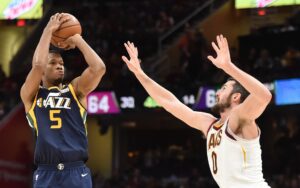Perhaps more than any other professional league in the U.S., the NBA is a league of personalities and individual player brands with ties to a multitude of economic markets. The league is diverse. Its investments and financial interests reflect that diversity through media branding, marketing, sponsorships, and business partnerships. Still, with so many branches on its financial tree, the NBA continues to explore new mediums. They are looking for avenues through which to monetize the product it delivers. Or otherwise, risk missing opportunities in emerging markets.
The NBA is Expanding Its Portfolio Away from the Court
The NBA has long had a connection with footwear companies. In the 90s, ties between the NBA and footwear behemoths Nike and Reebok catapulted the league and its partners even further into the cultural mainstream—along with the NBA’s elite stars (but mostly Michael Jordan, right?). The NBA sees the potential for partnerships to carry its brand to new heights. It has since prioritized staying ahead of the curve when it comes to sponsorships and commercial deal-making. To match pace with the successes of the NFL, they really have no choice.
Paradigm Shift
So, with the rise of social media, streaming video services, and mobile apps, it’s no surprise that the NBA has found ways to reap benefits from several emerging trends and technologies. Likewise, companies have found ways to tap into the NBA’s wide-reaching fan base and financial success. Among the NBA’s many partnerships— Pepsi, State Farm, and Nike among them — their recent partnership with MGM Resorts will carry them into new territory, allowing MGM to use official NBA data in their sports betting endeavors.
As the NBA enters this new arena, some may wonder whether it’s worth the risk of potentially ostracizing part of its fan base. But the risk isn’t as sharp or steep as it may seem. The partnership—or one like it—has been in the making for years, and the public has been prepped as well. Similarly to how companies such as EA Sports and 2K Sports have bridged the NBA with the video gaming industry, others have bridged the video-game-like control of fantasy sports with the NBA (primarily through websites and mobile apps).
Fantasy sports and sports betting are married through analytics and data. In addition to predicting outcomes based on that data. It becomes apparent that the partnership with MGM didn’t come out of the blue. The timing also makes perfect sense, given the Supreme Court’s decision on sports betting in 2018 and the expanding national market. Now that a public and direct path has been established between the NBA and sports betting entities, we will inevitably see more ventures such as Fox Bet—a merger between media powerhouse Fox and international iGaming giant The Stars Group—enter the market to find their share of the profits through online and mobile platforms.
New Horizons?
But, as with any relationship, no NBA partnership is a one-way street. As partners benefit from the NBA, the NBA also profits immensely from its partnerships. Aside from mega-figure deals with the footwear industry and the food/beverage industry, according to Jill R. Dorson of SportsHandle, the NBA will see a $585 million increase in revenue from sports betting (not to mention media rights and new partnerships that are yet to form). That puts a lot of weight on the scales if you’re evaluating risk versus reward. You can be sure that Adam Silver wants to guarantee that the NBA gets its rewards from sports betting profits.
Nonetheless, attentive eyes will be watching. Those eyes need to see how the league spends this revenue moving forward and where it goes next. The league has been under fire before, so scrutiny is no stranger. But in 2019, the spark of social opinion catches quick and the fire burns fast. One would imagine that Silver has accounted for many possible outcomes and reactions to the new partnership. But the next several months will reveal how accurate his forecasting really is.
Main Photo
Embed from Getty Images






